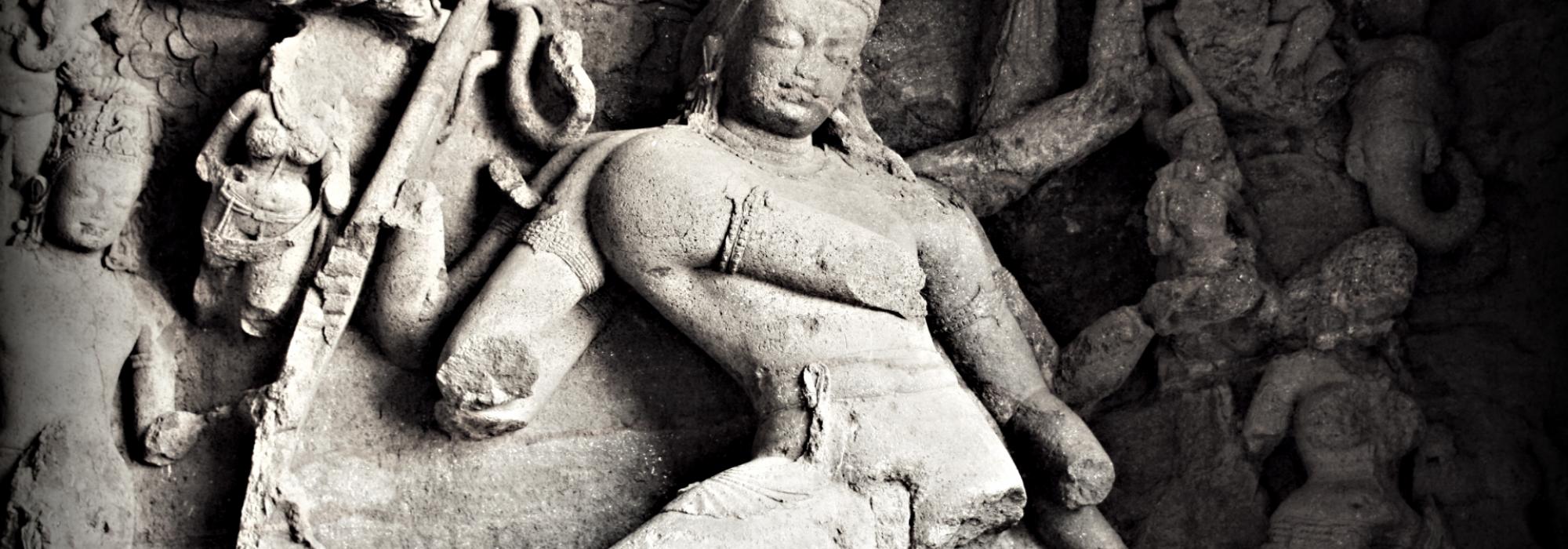Art—kalā—is an adroit phenomenon[1] that gives our mind the experience of some beauty or some grandeur or some profound thought through our eyes, ears, and other senses.
Experience—anubhava—is to become within our mind the sight of the object that we behold or the action that takes place in front of our eyes: by filling our inner realm with the emotion of the object before us and become one with it, almost like we are that object or that object is us. The object—lakṣya-vastu—and the subject—lakṣyakāra—get mixed up indistinguishably; this is the perfect state of Experience.
The arts are many. Our ancestors had a system of sixty-four arts. Let there be as many as one desires, but the most prominent ones are three –
1. Rūpa-citra [visual arts] – those that reach the mind through the doors of the eyes – image, sculpture, figure sketching, illustrations, painting, abhinaya, dance, and so forth.
2. Saṅgītā [music] – those that reach the mind through the doors of the ears
3. Kāvya [literature, poetry] – that which reaches the mind in the form of words and language
Mental Preparation
Experience is the coming together of the manas [mind] on one side and lakṣya-vastu [object of desire] on the other side. The essence of this statement is that a prior mental preparation is needed for such experience. The grasp of the qualties of art is proportial to the extent of education of the mind. Art experience follows saṃskāra, aesthetic refinement.[2]
The culturing and refinement of our mind—our manas-saṃskāra—is a product of the various experiences in our worldly life. Experience of the world and life-experiences are essential pre-requisites for both the creator of the art and the connoisseur of art. The creator of art observes the interesting aspects [of his art] and gives birth to the quintessence owing to the myriad experiences from his life. Similarly, it is through the lens of life-experiences that the art connoisseur realises the interesting aspects and embraces the quintessence.
Like this life-experiences, experience of the world, art creation and art experience are mutually related.
Three Stages
There are many stages and levels in art experience. The important ones among them can be identified as these three –
1. Manaḥ-prasāda [serenity of the mind]
2. Bhāvāveśa [intense emotional excitement]
3. Tātparya-cintanā [contemplation upon the essence]
Let us see in details about these three stages.
1. Rūpa-citra
1. Manaḥ-prasāda – In the visual arts, the element of mental serenity and pleasantness is seen in the common embellishments in drawings, in visual decoration. On the walls of a temple, we see a series of designs, of elephants, horses, lotuses, swans, wheels, or svastikas. The intention of these sculptures and images is to calm the mind of the viewer; to distract his mind from day-to-day worries and sorrows and to make him turn outward from inward. The women in our houses, after working in the kitchen or store-room for a long time, take a break to get out of the house, look at the view of the street for a while and then return after some time. That breaks their boredom and infuses freshness. By looking at a new scene, they get energised. This energy and pleasantness is the takeaway from the series of decorative sculptures on the temple wall. This is the first step.
2. Bhāvāveśa – Next we see the vigrahas on the walls of the inner pavilion. There is a specific meaning to each of these sculptures. For the mind to concentrate deeper, we get far more robust ingredients here. Therefore, the mind remains rooted here for a while; there is focus, stillness, absorption. Dhruva is performing tapas! Ah, how is this small child able to concentrate with such immersion! Oh, see Mārkaṃḍeya there! What remarkable faith he had! And what do we have here? Mother Sītā! Ah, what extraordinary fortitude she had, what commitment to tapas! And there, Vāmana-mūrti; he is blessing Emperor Bali in the guise of a punishment! In this manner, our mind starts imagining various episodes and is engulfed by intense emotion. In the static shapes we see our emotions moving. As we see these sculptures, the mind gets into the story behind them, and there is a flood of emotions, and that is rasa. Relishing rasa is the high gopura of art accomplishment.
3. Tātparya-cintanā – At third stage, we leave the temple and go home or elsewhere. But the images of those vigrahas stay in our mind. They evoke, instigate, and awaken different emotions inside us. The result of this sustained meditation is the completeness of relishing rasa. When relishing rasa is complete, we become one with the work of art and forget our existence. This is the pinnacle of art experience.[3]
mārge mārge jāyate sādhu saṅgaḥ
saṅge saṅge śrūyate kṛṣṇa-kīrtiḥ
kīrtau kīrtau nas-tadākāra-vṛttiḥ
vṛttau vṛttau saccidānanda-bhāsaḥ॥
[Rambhā-śuka-Saṃvāda, verse 2][In every path, one gets the company of the good
in every such company, one hears the glory of Kṛṣṇa
in every such praise, we become aware of
his form and being – and adopt it
in every such being and adoption,
we experience saccidānanda]
2. Saṅgītā
Even in experiencing music there are three stages as seen earlier.
1. Manaḥ-prasāda – A musical concert starts with a popular song, a varṇa (a type of musical form), a song in praise of the guru or a devotional song. That brings joy to our mind and draws our attention. Slowly our mind flows towards the sea of rāgas.
2. Bhāvāveśa – After singing the introductory songs we see the greatness of music. The singer takes a grand kṛti, or a pallavi (a lyrical line set to music), which gives ample opportunity to expand a rāga. In various parts of the composition he demonstrates the variety and beauty of the rāga. Here the aspects that are most effective are these two –
i. Dhātu, the uninterrupted flow of the melody
ii. Mātu, the blossoming of the lyric in all its clarity
By the utterance of the words of the lyric, the beauty of the melody is doubled. The mātu of a musical composition can be compared to the craftsmanship in a vigraha. The singer’s melodic tuning of the lyric is akin to the colours on the sculpture, which make its shape more pronounced, more charisma. No doubt melody without lyric generates emotion. However, it lacks specificity and clarity of the parts. This makes it difficult to identify accurately the emotion experienced. When lyric is present, the emotional response can be identified clearly as joy, romance, pity, complete surrender, or any anguish of the heart. Along with that the suggested meanings of the lyric will treat us to a variety of flavours like islands, rocks, and waterfalls in the midst of the great flow of melody. A singer builds his rāga edifice from the stones and bricks of these suggestions. His design of rāga appears sometimes like a palace, sometimes like a series of steps to climb something.
bhūsurādi samasta-jana-pūjitābja-caraṇāya।
vāsuki-takṣakādi-sarpa-svarūpa-dharaṇāya॥
When such expansive lyrics are rendered by a singer endowed with good taste and refinement, within our minds we feel like we are in the palace of a king or a big auditorium and feel elevated, forgetting ourselves.
The words may be ordinary and the meaning is well-known to us. But the effect of the rāga is extraordinary. The power that’s absent in [standalone] words is found in the great flow of syllables and letters. The dancing of the waves of the melody is owing to these letters.
The obliqueness, slides, twists and turns, gentle ripples, and intense impulses present in the singer’s voice – these varied movements stir and shake our hearts and evoke waves of emotion within us. Melody is a flow. The utterances of letters are the waves. In singing, the lyric is indeed important but the multi-dimensional effect that the melody creates taken on greater importance. In the oneness of the rāga-flow, the words and letters bring multiplicity; just as in a garland [strung together on a single thread], there is a multiplicity of flowers and leaves. This multitude evokes a variety of flavours. A rice dish is one, the grains of rice are many. When the mind is immersed in musical flow that is a blend of dhātu and mātu, the experience of rasa reaches its complete expression.
3. Tātparya-cintanā – Next comes the third stage. Now the syllables of melody are not falling on the external ears. The tānpura has gone silent. The singer is not there in front of us. But a fragment of the melody he sung is resonating in our inner ear. Wherever we go, that melody stays with us. This reverberation is the pinnacle of musical experience.[4] The music of the singer has been imprinted in our internal landscape.
Bits and pieces of lines like these –
hariye – idu sariye।
[“Hari, is this right?” – a line in Kannada]
na hi re – na hi śaṅkā।
[“There is no doubt at all” – a line in Sanskrit]
èndaro mahānubhāvulu।
[“So many great people” – a line in Telugu]
stay in our memory and cultures our mind. It destroys our ego. It purifies our behaviour and makes us humble. This elevation and purification of the heart is beauty in life.
To be concluded.
This is the first part of the twenty-fourth essay in D V Gundappa’s magnum-opus Jnapakachitrashaale – Vol. 2 – Kalopasakaru. Edited by Hari Ravikumar.
Footnotes
[1] The original has ‘kuśala karma.’ The word ‘kuśala’ means ‘good,’ ‘auspicious,’ ‘skilled,’ ‘proficient,’ etc. and ‘karma’ means ‘action.’
[2] In other words, the richness of the art experience depends on how cultured the mind is.
[3] The original has, ‘ಇದು ಕಲಾನುಭವ-ಗೋಪುರದ ಕಲಶ’ – literally, ‘This is the kalaśa of the gopura of kalānubhava.’
[4] The original has, ‘ಈ ಅನುರಣಿತವೇ ಗಾನ-ಗೋಪುರದ ಕಲಶ’ – literally, ‘This resonance is the kalaśa of the music-gopura.’











































